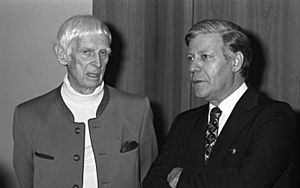Gerhard Marcks facts for kids
Quick facts for kids
Gerhard Marcks
|
|
|---|---|

Gerhard Marcks (left) with Helmut Schmidt
|
|
| Born | 18 February 1889 |
| Died | 13 November 1981 (aged 92) Burgbrohl, West Germany
|
| Nationality | German |
Gerhard Marcks (born February 18, 1889 – died November 13, 1981) was a famous German artist. He was best known for his sculptures, which are artworks made by carving or shaping materials. He also created many drawings, woodcuts (prints made from carved wood), lithographs (prints made from stone), and ceramics (art made from clay).
Contents
Early Life and Art Groups
Marcks was born in Berlin, Germany. When he was 18, he started learning from another sculptor named Richard Scheibe. In 1914, he married Maria Schmidtlein, and they had six children together. During World War I, he served in the German army, which caused him to have health problems later in life.
Gerhard Marcks was part of several art groups. These included the Novembergruppe (November Group) and the Arbeitsrat für Kunst (Workers Council for Art). These groups were made up of artists who wanted to change art and society after the war. He was also connected to the Deutscher Werkbund, a group that aimed to combine art with industry and design.
Teaching at the Bauhaus School
In 1919, a very important art school called the Bauhaus was started in Weimar, Germany, by architect Walter Gropius. Marcks was one of the first teachers hired there. He became the Formmeister (Form Master) for the school's Pottery Workshop. This workshop was in Dornburg, a town near Weimar.
In the Pottery Workshop, students learned how to make pottery. Another teacher, Master Potter Max Krehan, taught them how to use a potter's wheel and how to glaze and fire their creations. Marcks taught the history of pottery and encouraged students to try new things. He also sometimes decorated the pots himself.
At first, Marcks created models for animal sculptures. These were even made into porcelain figures in China. His early art included woodcuts of animals, like "The Cats" and "The Owl." Over time, he became more interested in sculpting human figures. This became the main focus of his art for the rest of his life.
Later Career and Challenges
In 1925, the Bauhaus school moved to Dessau, and its pottery workshop closed. Marcks then moved to the Kunstgewerbeschule (School of Applied Arts) near Halle. He became the director of this school. However, in 1933, he was fired because the Nazis did not approve of his artwork.
The Nazis called his art "degenerate art," meaning they thought it was bad or harmful. Several of his works were even shown in a special exhibition in Munich in 1937 that mocked artists like him. Other famous Bauhaus artists, such as Wassily Kandinsky and Paul Klee, also had their art shown there.
Even though his art was criticized, Marcks stayed in Germany during World War II. In 1937, the Nazis took and destroyed 24 of his artworks. He was also told he couldn't show his art or even work as an artist. During this difficult time, he traveled to Italy to work. In 1943, his studio in Berlin was bombed during an air raid, and many more of his artworks were lost.
After World War II, Marcks became a professor of sculpture at the Regional Art School in Hamburg. He taught there for four years before moving to Cologne. He also designed memorials to honor soldiers and people who died in the war. His art was even part of the art competitions at three Olympic Games.
Death and Lasting Legacy
Gerhard Marcks passed away in 1981 in Burgbrohl, Germany. Ten years before his death, a museum was opened in his honor in Bremen, Germany. This museum, called the Gerhard Marcks Haus, has a permanent collection of his art. It includes 12,000 of his sketches, 900 prints, and about 350 of his sculptures.
In the United States, Luther College in Decorah, Iowa, also has a collection of Marcks' work. This includes drawings, prints, and bronze sculptures. Many of these were given to the college by his former student, Marguerite Wildenhain. A very large bronze statue by Marcks, called Oedipus and Antigone (made in 1960), was placed at Luther College in 2000.
Honors and Exhibitions
Gerhard Marcks' work was shown in many important art exhibitions:
- In 1914, he showed his art at the Berlin Secession and the Deutscher Werkbund.
- After World War II, his art was displayed at the Venice Biennale and the Documenta exhibitions in Kassel (in 1955, 1959, and 1964).
He also received many awards for his contributions to art:
- In 1949, he received the Goethe Plaque of the City of Frankfurt.
- In 1952, he was made a Knight of the Peace Class of the Order Pour le Mérite.
- In 1954, he won the Grand Art Prize from North Rhine-Westphalia.
- In 1955, the city of Berlin gave him its Art Prize.
- In 1962, the Academy of Fine Arts, Nuremberg, made him an honorary member.
- In 1979, for his 90th birthday, exhibitions were held in his honor in Berlin, Bremen, Cologne, and Nuremberg. He also received the Grand Cross of Merit of the Federal Republic of Germany.
- In 1980, the American Academy of Arts and Letters in New York made him an honorary member.
- In 1991, a small planet (asteroid) discovered on April 9 was named 10778 Marcks in his honor.
Gallery
-
A bronze statue depicting the Bremen Town Musicians located in Bremen
-
"The mourner old Woman" (1955), Bochum
See also
 In Spanish: Gerhard Marcks para niños
In Spanish: Gerhard Marcks para niños
- Der Rufer








